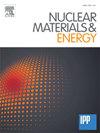不同温度热处理对高级陶瓷增殖石结构和辐射诱导效应的影响
IF 2.7
2区 物理与天体物理
Q1 NUCLEAR SCIENCE & TECHNOLOGY
引用次数: 0
摘要
由65摩尔%正硅酸锂(Li4SiO4)和35摩尔%重钛酸锂(Li2TiO3)组成的高级陶瓷增殖器(ACB)鹅卵石目前正在开发中,作为欧盟未来热核融合反应堆中氚增殖的参考材料。在本工作中,研究了不同温度下的热处理对ACB鹅卵石结构和辐射诱导效应的影响。在不同的气氛(空气、氩气和真空)中,在500至1000℃的选定温度下对生产的ACB鹅卵石进行热处理,然后使用能量高达45 keV的x射线照射。利用电子顺磁共振(EPR)谱分析了辐照ACB鹅卵石在热处理前后形成和积累的顺磁致缺陷中心。为了确定相变的确切温度,并评估热处理对辐照前ACB卵石的晶体结构、化学键振动和微观结构的影响,应用了其他几种相关的物理化学分析方法:差示扫描量热法(DSC/TG),粉末x射线衍射(PXRD)技术,衰减全反射-傅里叶变换红外(ATR-FTIR)光谱,扫描电子显微镜(SEM)。根据得到的结果,可以得出结论,温度高于700°C的热处理会影响x射线照射产生的顺磁中心的分布。这可能是由于Li4SiO4相在600 ~ 750℃之间发生了从“低温”到“高温”结构的二级相变。所获得的结果强调了在使用EPR光谱技术分析这些陶瓷材料时,在辐照前考虑所生产的ACB鹅卵石的热处理温度的重要性。本文章由计算机程序翻译,如有差异,请以英文原文为准。
Influence of thermal treatment at various temperatures on structure and radiation-induced effects in advanced ceramic breeder pebbles
Advanced ceramic breeder (ACB) pebbles consisting of 65 mol% lithium orthosilicate (Li4SiO4) and 35 mol% lithium metatitanate (Li2TiO3) are currently being developed as the European Union’s reference material for tritium breeding in future thermonuclear fusion reactors. In the present work, the influence of thermal treatment at various temperatures on structure and radiation-induced effects in the ACB pebbles is investigated. The produced ACB pebbles were thermally treated at selected temperatures between 500 and 1000 °C in different atmospheres (air, argon, and vacuum) and afterwards irradiated using X-rays with energies up to 45 keV. The formed and accumulated paramagnetic radiation-induced defect centres in the irradiated ACB pebbles before and after thermal treatment were analysed using electron paramagnetic resonance (EPR) spectroscopy. To determine the exact temperatures of the phase transitions and evaluate the influence of thermal treatment on the crystal structure, chemical bond vibrations, and microstructure of the ACB pebbles before irradiation, several other relevant physico-chemical analytical methods were applied: differential scanning calorimetry/thermogravimetry (DSC/TG), powder X-ray diffraction (PXRD) technique, attenuated total reflectance – Fourier transform infrared (ATR-FTIR) spectroscopy, and scanning electron microscopy (SEM). On the basis of the obtained results, it can be concluded that thermal treatment at temperatures higher than 700 °C influences the distribution of paramagnetic centres generated by exposure to X-rays. This is probably due to the second-order phase transition from “low-temperature” to “high-temperature” structure of the Li4SiO4 phase between 600 and 750 °C. The obtained results highlight the importance of considering the thermal treatment temperature of the produced ACB pebbles prior to irradiation when analysing these ceramic materials using EPR spectroscopy techniques.
求助全文
通过发布文献求助,成功后即可免费获取论文全文。
去求助
来源期刊

Nuclear Materials and Energy
Materials Science-Materials Science (miscellaneous)
CiteScore
3.70
自引率
15.40%
发文量
175
审稿时长
20 weeks
期刊介绍:
The open-access journal Nuclear Materials and Energy is devoted to the growing field of research for material application in the production of nuclear energy. Nuclear Materials and Energy publishes original research articles of up to 6 pages in length.
 求助内容:
求助内容: 应助结果提醒方式:
应助结果提醒方式:


